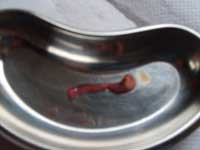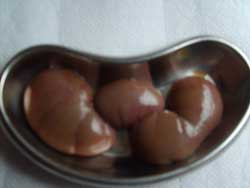Hamsters are tiny creatures that are prone to many illnesses. Some of these illnesses can be deadly and can kill your hamster quickly. Moreover, unlike human beings, hamsters cannot convey when they are sick. So, the onus is on you, the hamster owner, to find out if your hamster is sick and take the right measures to protect him.
Pyometra is one such illness that affects hamsters. Pyometra in hamsters can become life-threatening quickly. But you don’t have to worry. This blog post lists the types of pyometra, how to determine if your hamster suffers from it, and how to treat it. So, continue reading.
What is Pyometra?
Pyometra is a dangerous condition that affects the uterus of female hamsters. During the estrus cycle of a female hamster, i.e., when she comes into heat and is ready to mate, her body creates uterine secretions. These secretions serve as a suitable environment for dangerous bacteria to grow.
So, if she gets infected during this time by bacteria such as Escherichia coli or streptococcus or by the lymphocytic choriomeningitis virus, pus or blood starts accumulating in her uterus, sometimes followed by the discharge of this accumulated fluid.


But that doesn’t mean pyometra can only infect a hamster during her estrus cycle. It can also infect her after mating, pregnancy, or phantom pregnancy (Source: Petsbubble). It can also occur after a spay surgery. Pyometra can infect hamsters of any age, even though it is commonly observed in older female hamsters. It can affect hamsters who have given birth as well as those who haven’t.
So, as you can see, pyometra is a dangerous condition for female hamsters because it can affect them at any age, regardless of their lifestyle. Hence, a hamster owner has to be cautious at all times.
Now that you know what pyometra in hamsters is, find out how many types of pyometra are there and how to differentiate between them.
Types of Pyometra in hamsters
Open Pyometra
In this type of pyometra, the fluid that accumulates in the uterus comes out through the vulva. So, if you find blood or foul-smelling pus coming out of your female hamster’s genital area, it is definitely a cause for concern.
Hamsters don’t menstruate. So, blood doesn’t come out of a hamster’s vulva normally. Therefore, if you notice a bloody discharge from your hamster’s genital area, it could be open pyometra.
Open pyometra is easy to spot and easy to treat because the fluid accumulated in the hamster’s body can be drained easily.
Closed Pyometra
Contrary to open pyometra, in closed pyometra, the accumulated fluid doesn’t come out of the hamster’s body on its own. This is because the cervix, which forms a canal between the uterus and the vagina, is closed. Hence, the accumulated fluid cannot come out of the hamster’s body because it is trapped inside the uterus.
Only after several days of contracting closed pyometra does the abdomen start to bulge or swell. So, unfortunately, closed pyometra is difficult to detect early. But if left untreated until the later stages, instead of discharging the pus outside the body (because it is impossible due to a closed cervix), the uterus might rupture and release the pus into the abdomen. As a result, toxins and harmful microorganisms might spread into the bloodstream, causing blood poisoning.
So, if your female hamster’s abdomen appears swollen or if she seems lethargic, take her to a vet immediately.
Open and closed pyometra can be detected by the symptoms they display. But just like any other disease, these symptoms are not unique to these conditions alone. For example, a discharge from the vagina could be due to a bladder problem. Your hamster might not have open pyometra after all. Similarly, your hamster’s abdomen can swell due to tumors, cysts, etc. It doesn’t necessarily mean that she is suffering from closed pyometra. That’s why it is imperative to consult a vet as soon as possible once you notice any of these symptoms.
Symptoms of Pyometra
In the section above, we looked at the most common symptoms of the two different types of pyometra. But a hamster suffering from pyometra could show other additional symptoms as well, like being lethargic, becoming hunched more than usual, drinking a lot of water, urinating a lot but eating less, and/or getting irritated easily. So, if you notice any of these symptoms, take your hamster to a vet as soon as possible because these are the signs of pyometra.
Diagnosis
Your vet can diagnose pyometra, usually using the symptoms and signs observed during a clinical examination. But sometimes, this may not be possible. In such cases, the vet can administer an anesthetic to your hamster and do an ultrasound scan or an X-ray. But it can be difficult to perform these procedures due to the hamster’s size.
Don’t forget to take a sample of a discharge if available. The vet can use it to diagnose Pyometra (Source: Vectis hams).
Treatment for pyometra in hamsters
There are only three ways to treat pyometra in hamsters.
1. Surgical treatment
Even though there are three methods to treat pyometra, the only method that offers a significant chance of success is a surgical procedure.
In the surgical procedure for curing pyometra, the womb of the hamster is removed. This procedure is called spaying. Spaying can be performed on Syrian hamsters and Chinese hamsters. But due to their small size, spaying is not as successful in Chinese hamsters as in Syrian hamsters. But pyometra is also more common in Syrian hamsters than in Chinese hamsters.
Hamsters recover faster after surgery. So, they can get back to their feet soon after the surgery. But they still need to be administered pain killers and antibiotics for several days after the surgery. Moreover, you should also prepare the cage so that your hamster can rest peacefully for a few days. You can use the tips below to help you:
How to prepare the cage to help your hamster recover faster after a surgery?
- Take out hamster toys from the cage.
- Leave the top open if possible so that you have easy access to your hamster.
- Keep food and water near her nest so that she doesn’t have to walk much to get to them.
- For a few days, she will understandably be stressed. So, don’t try to handle her or play with her during this time.
- Keep the room warm.
- Finally, have a travel basket or cage ready filled with lots of soft bedding and tissues so that you can take her to the vet as quickly as possible in case of an emergency (Source: Hamster Central).
Even though surgery is the best solution for pyometra in hamsters, it can be very expensive, costing more than a thousand dollars. Moreover, for elderly hamsters, surgery can be pretty difficult to survive. So, sometimes, you may have to go for the less successful alternatives.
2. Antibiotic treatment
Another method to treat pyometra in hamsters is to administer antibiotics to them. However, antibiotics only provide temporary relief to your hamster. They are very ineffective when it comes to curing pyometra. However, using antibiotics on a long-term basis can be helpful for a hamster that is suffering from pyometra. But antibiotics can also kill the gut bacteria of hamsters. So, while using long-term antibiotics, it is vital to use probiotic supplements.
3. Extreme cases
In extreme cases of pyometra, such as when it occurs in older hamsters, there isn’t much you can do as a pet owner to help your pet.
However, if your hamster doesn’t seem to be suffering much, like not in too much pain, you can still use antibiotics with painkillers.
But if your hamster’s case is even more severe, and if she is suffering from a lot of pain and refuses to eat, you may have to consider euthanasia. Euthanasia is never an easy decision to make. But if you do make that brave decision, put some familiar bedding, substrate, and her favorite food in the carrier in which you plan to take her to the vet. That way, she can at least cherish her last moments.
Things to note
- As explained before, pyometra could either be caused by a bacterial or a viral infection. If the cause of pyometra is a bacterial infection, then the disease is contagious. So, if you house more than one dwarf hamster in a cage, you should separate the sick hamster from the healthy hamster. If not, pyometra could spread from the infected hamster to the healthy hamsters as well.
- Since the surgical treatment for pyometra is pretty expensive, having a vet fund aid helps a lot.



